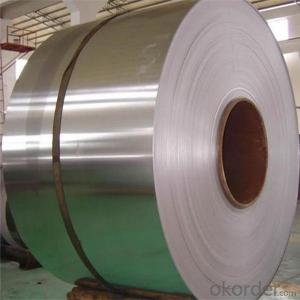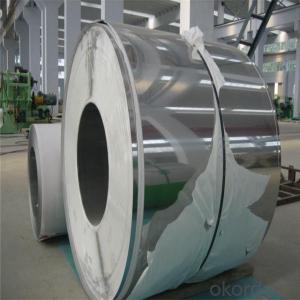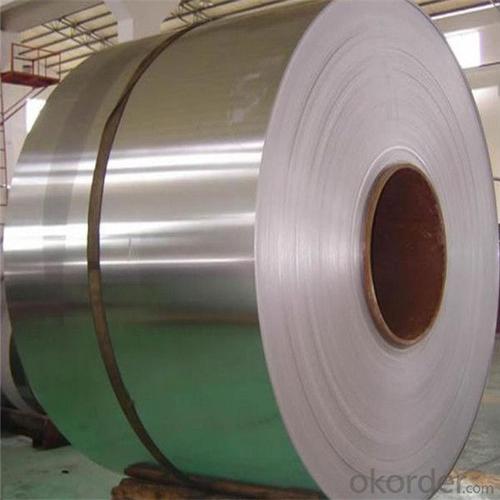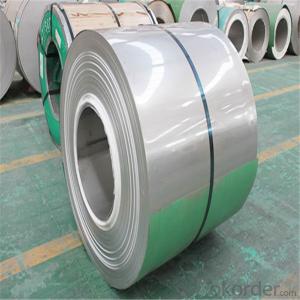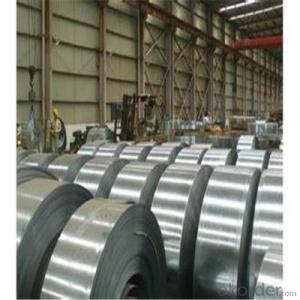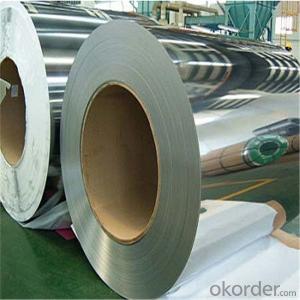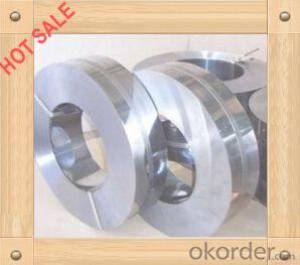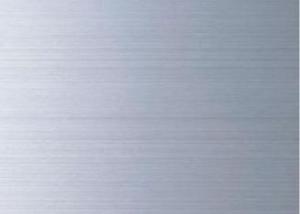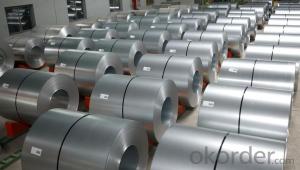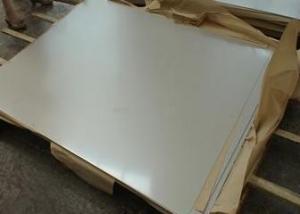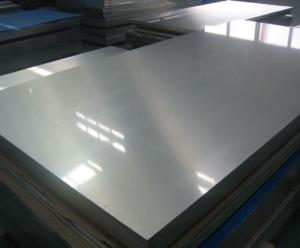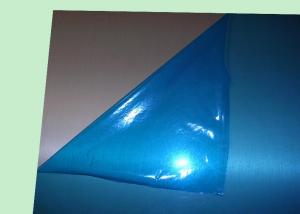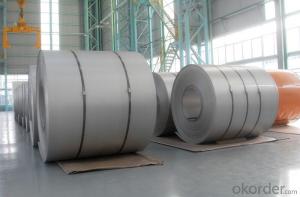Stainless Steel Coil Price Per KG in China
- Loading Port:
- Shanghai
- Payment Terms:
- TT OR LC
- Min Order Qty:
- 4 m.t.
- Supply Capability:
- 10000 m.t./month
OKorder Service Pledge
OKorder Financial Service
You Might Also Like
Specification
Detailed Product Description
Product Name: stainless steel coil
Features:
1) Grade: 430, 301,304, 316L, 201, 202, 410, 304
2) Specs: Thickness 0.3-3mm Width 20~ 480mm x C
We also produce other specification according to customer's requirements.
3) Executed Standard: JIS, ASTM, GB
4) Packing: plastic bag, weaving bag, wooden case or according to the customers
5) Applications: construction, decoration, machinery furniture, automobile, fluid transportation, Industry instrument, agriculture, kitchenware
6) Cold Rolling Thick:0.3mm-3.0mm Width:365-480
Specifications
Cold Rolled Stainless Steel Mill/Slit Coil
1. Grade: 200 & 300 series
200 seriers: 201,202, J4
300 seriers: 301, 304, 304L, 321, 316L, 309, 310S
2. Standard: JIS, ASTM, AISI, GB, DIN, EN, we usually use ASTM and GB Standard
3. Thickness: 0.14mm-3.0mm
4. Width: 10-700mm
5. Surface: 2B finished, BA finished
6. Hardness: soft, 1/4H, 1/2H, FH
7. Thickness Tolerance: +/-0.02mm
8. Width Tolerance: +/-10mm(mill edge)
Hot Rolled Stainless Steel Coil
1. Grade: 200 & 300 & 400 series
200 seriers: 201,202
300 seriers: 301, 304, 304L, 316L, 309, 310S,321
400 seriers: 410, 410S, 409L,430
2. Standard: JIS, ASTM, AISI, GB, DIN, EN, we usually use ASTM and GB Standard
3. Thickness: 2.4mm-6.0mm
200 series: 2.4mm-6.0mm
300 series: 2.4mm-6.0mm
400 series: 2.4mm-6.0mm
4. Width: 405mm-700mm
5. Surface: No1 finished, mill edge
6. Hardness: soft
7. Thickness Tolerance: +/-0.1mm
8. Width Tolerance: +/-10mm
9. Mills: Quanxing, Xingda
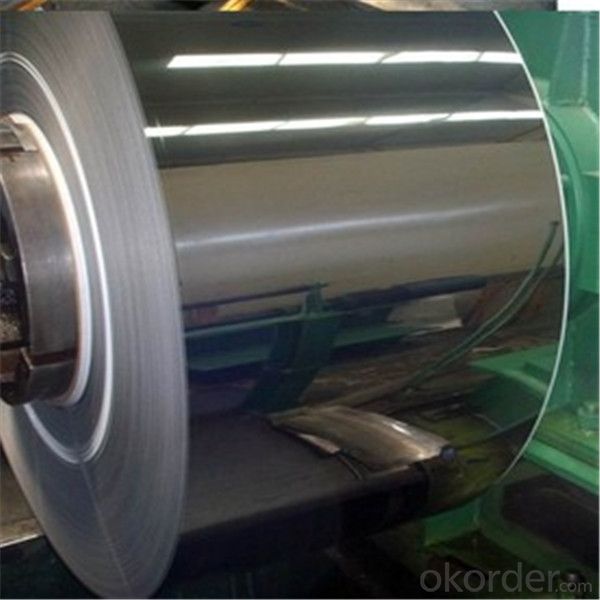
Producing Line of Stainless Steel Coil
1. 750mm 6-rolling mill (CR)
2. 850mm 2-rolling mill (HR)
5. 8 sets of bright annealing producing line (CR)
3. 8 sets of pickling and annealing line (HR)
6. 2 sets tension levelers
7. 2 sets degreasing cleaning lines
8. 4 sets slit cutting machine
9. 2 sets cutting plate machine
10. 1 set mulch applicator with PVC
11. 1 set wrapping machine
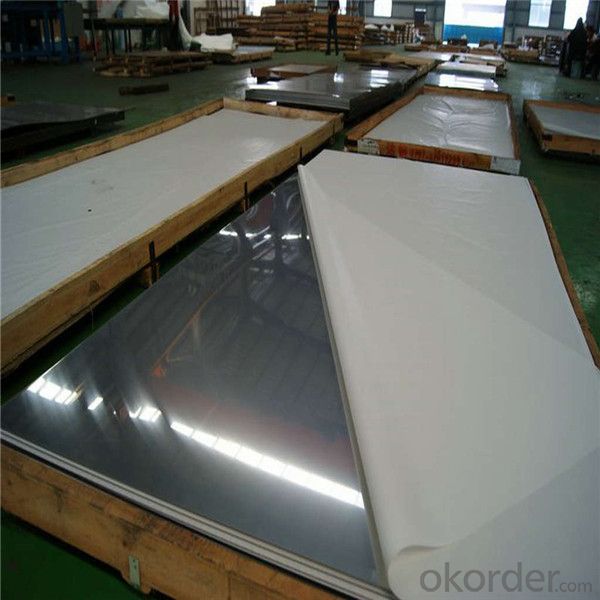
Applications
1.Automotive: Automotive trim and molding/Difficult-to-form exhaust-system components, tubular manifolds, mufflers/Exhaust manifold and other exhaust-system components, catalytic converter shells, clamps
2.Construction: Gutters and downspouts, roofing, siding
3.Kitchenware: Cooking utensils, dishwashers, ovens, range hoods, refrigerators, skewers
4.Chemical processing: Oil refinery equipment, oil burner and heater parts
5.Appliances: Hot water tanks, residential furnaces
6.Power generation: Heat Exchanger tubing
7.Farming:Dry fertilizer spreaders/Farm animal pens
- Q: What is the creep strength of stainless steel strips?
- The creep strength of stainless steel strips refers to the material's ability to withstand long-term deformation under elevated temperatures and constant load. Stainless steel is known for its excellent creep resistance due to its high alloy content and specific microstructure. The creep strength of stainless steel strips depends on various factors such as the alloy composition, heat treatment, and grain size. In general, stainless steel strips have a high creep strength compared to other materials, especially at elevated temperatures. The presence of elements like chromium, nickel, and molybdenum enhances the creep resistance of stainless steel, allowing it to maintain its shape and structural integrity for extended periods under constant load. Additionally, the heat treatment process plays a crucial role in optimizing the creep strength of stainless steel strips. Proper heat treatment techniques like annealing or solution treatment followed by aging can help to enhance the material's microstructure and reduce the formation of harmful phases, such as sigma phase, that can decrease creep resistance. The grain size of stainless steel also affects its creep strength. Fine-grained stainless steel strips tend to exhibit better creep resistance compared to coarse-grained ones. This is because fine grains hinder the movement of dislocations, which are responsible for creep deformation. Overall, the creep strength of stainless steel strips is relatively high, making them suitable for applications that require resistance to long-term deformation and high temperatures, such as in power generation, aerospace, and chemical processing industries.
- Q: Can stainless steel strips be electroplated?
- Certainly, it is possible to electroplate stainless steel strips. Electroplating involves the application of a slender metal layer onto an object's surface through the utilization of an electric current. While stainless steel is already resistant to corrosion, electroplating can augment its visual appeal, offer additional protection against wear and tear, and enhance its conductivity. The procedure encompasses submerging the stainless steel strip into a solution containing metal ions and subsequently applying an electric current, which results in the attraction and deposition of the metal ions onto the strip's surface. This technique can be employed with various metals, like gold, silver, nickel, or chromium, in order to achieve diverse aesthetic or functional qualities.
- Q: What are the dimensions of stainless steel strips?
- The dimensions of stainless steel strips vary depending on their specific application and manufacturer. However, common dimensions for stainless steel strips range from 0.1 to 3.0mm in thickness and 10 to 600mm in width.
- Q: Are stainless steel strips suitable for elevator interiors?
- Yes, stainless steel strips are suitable for elevator interiors. Stainless steel is a highly durable and versatile material that is commonly used in various applications, including elevator interiors. Its properties make it an excellent choice for elevator interiors due to its resistance to corrosion, easy maintenance, and ability to maintain a polished and sleek appearance over time. Stainless steel strips can be used to enhance the aesthetic appeal of the elevator interior, providing a modern and sophisticated look. Additionally, stainless steel is easy to clean and sanitize, making it a hygienic choice for elevator interiors, especially in high-traffic areas. Overall, stainless steel strips are a suitable and practical option for elevator interiors, offering both durability and aesthetic appeal.
- Q: Can stainless steel strips be used in the nuclear industry?
- The nuclear industry finds stainless steel strips highly useful. Its exceptional corrosion resistance and mechanical properties make stainless steel a popular choice for various applications in this industry. Stainless steel is commonly employed in the construction of nuclear power plants, nuclear reactors, and related equipment. In the nuclear industry, stainless steel strips serve numerous purposes. For example, they play a crucial role in fabricating nuclear fuel assemblies - essential components of nuclear reactors. These fuel assemblies house fuel rods that produce heat through nuclear fission. The use of stainless steel strips ensures the structural integrity and safety of the fuel assemblies by providing necessary support. Furthermore, stainless steel strips are utilized in constructing containment vessels and pressure vessels in nuclear plants. These vessels are responsible for containing radioactive materials and ensuring the safety of personnel and the surrounding environment. Stainless steel's resistance to corrosion and ability to withstand high temperatures make it an ideal choice for these critical applications. Moreover, stainless steel strips are employed in manufacturing various components like piping systems, heat exchangers, valves, and pumps in nuclear facilities. These components require materials that can endure harsh operating conditions, including high temperatures, radiation exposure, and corrosive environments. Stainless steel's durability and resistance to corrosion make it a reliable material for these applications. In conclusion, the nuclear industry extensively relies on stainless steel strips due to their exceptional properties, making them suitable for diverse applications. The industry depends on stainless steel's corrosion resistance, mechanical strength, and high-temperature tolerance to ensure the safety and efficiency of nuclear power generation.
- Q: How do stainless steel strips resist chemical exposure?
- Stainless steel strips resist chemical exposure due to their high levels of corrosion resistance. The presence of a thin layer of chromium oxide on the surface of stainless steel acts as a protective barrier against chemical reactions and prevents the metal from rusting or corroding. This passive layer forms when chromium in the steel reacts with oxygen in the atmosphere, creating a strong and durable surface that can withstand a wide range of chemical substances. Additionally, stainless steel is often alloyed with other elements such as nickel or molybdenum, further enhancing its resistance to chemical exposure.
- Q: Do you have stainless steel with magnetic?
- The chromium content of ferritic stainless steel (400 Series) is 15%~30%, and has the structure of body centered cubic crystal. This kind of steel does not contain nickel, sometimes also contain a small amount of Mo, Ti, Nb and other elements, this kind of steel has high heat conductivity, low expansion coefficient, good oxidation resistance and anti stress excellent characteristics of stress corrosion, used formanufacturingthecorrosionresistanceofthe atmosphere, water vapor, waterandoxidizing parts.
- Q: What are the factors affecting the weldability of 111 stainless steel strips?
- The factors affecting the weldability of 111 stainless steel strips include the composition and purity of the steel, the presence of impurities or contaminants, the heat input during welding, the welding technique used, the type and composition of the filler material, and the welding parameters such as current, voltage, and travel speed. Additionally, the condition of the surface, including its cleanliness and roughness, can also affect the weldability of the stainless steel strips.
- Q: What are the common uses of stainless steel strips in the aerospace structural components?
- Due to their unique properties and advantages, stainless steel strips have various applications in aerospace structural components. These include: 1. Providing structural support: Aircraft frame structures often utilize stainless steel strips to ensure strength and stability. They are commonly found in wing spars, fuselage frames, and other load-bearing components. 2. Manufacturing fasteners and connectors: Stainless steel strips are well-suited for aerospace applications where fasteners and connectors are needed. Their high tensile strength, resistance to corrosion, and ability to withstand extreme temperatures make them ideal for securing and joining different structural elements. 3. Constructing exhaust systems: Stainless steel strips are an excellent choice for constructing exhaust systems in aerospace engines. They can withstand the high temperatures and corrosive gases generated by the engines, ensuring the longevity and reliability of the system. 4. Fabricating fuel and hydraulic lines: Stainless steel strips are frequently used in the fabrication of fuel and hydraulic lines within aircraft. Their corrosion resistance and ability to handle high pressures make them reliable for transporting essential fluids throughout the aircraft. 5. Creating heat shields: In aerospace applications, stainless steel strips are utilized in the construction of heat shields. These shields protect sensitive components from the high temperatures generated by engines, enabling proper functionality and extending their lifespan. 6. Manufacturing interior components: Stainless steel strips are also employed in the manufacturing of various interior components such as cabin fittings, seat structures, and galley equipment. Their aesthetic appeal, durability, and resistance to wear and tear enhance the overall passenger experience and ensure safety. In conclusion, stainless steel strips are widely utilized in aerospace structural components due to their strength, corrosion resistance, ability to withstand high temperatures, and reliability. Their versatility and performance make them an essential material in the aerospace industry.
- Q: What are the common methods of cutting stainless steel strips?
- There are several common methods used for cutting stainless steel strips. 1. Shearing: This method involves using a sharp blade to cut through the steel strip. It is often used for thinner strips and provides a clean and accurate cut. Shearing machines or hydraulic shears are commonly used for this process. 2. Laser Cutting: Laser cutting is a highly precise method that uses a focused laser beam to cut through the stainless steel strip. It is suitable for both thin and thick strips and allows for intricate designs and shapes to be cut. Laser cutting machines are often computer-controlled, ensuring accuracy and repeatability. 3. Plasma Cutting: Plasma cutting is another method used for cutting stainless steel strips. It involves using a high-temperature plasma arc to melt through the metal and create a cut. Plasma cutting machines are versatile and can cut through different thicknesses of stainless steel strips. 4. Water Jet Cutting: Water jet cutting uses a high-pressure jet of water mixed with an abrasive material to cut through the stainless steel strip. This method is suitable for various thicknesses and can produce precise cuts without heat-affected zones. Water jet cutting machines are often computer-controlled, making it ideal for complex shapes and designs. 5. Abrasive Cutting: Abrasive cutting methods involve using abrasive discs or wheels to grind through the stainless steel strip. This method is commonly used for thicker strips and can be performed manually or with the help of power tools such as angle grinders. It is important to consider the specific requirements of the project, such as the thickness and design of the stainless steel strip, when choosing the appropriate cutting method. Additionally, safety precautions and proper equipment should always be used when cutting stainless steel strips to ensure a successful and safe outcome.
Send your message to us
Stainless Steel Coil Price Per KG in China
- Loading Port:
- Shanghai
- Payment Terms:
- TT OR LC
- Min Order Qty:
- 4 m.t.
- Supply Capability:
- 10000 m.t./month
OKorder Service Pledge
OKorder Financial Service
Similar products
Hot products
Hot Searches
Related keywords
